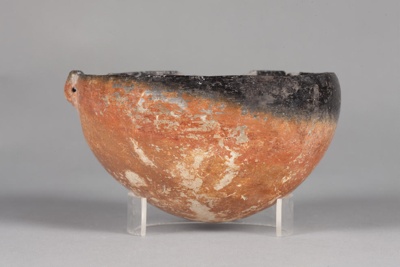< Collection search
< Collection highlights
From:UC Teece Museum of Classical Antiquities
Name/TitleBowl
About this objectThis Bronze Age knob lug bowl was found in a pit-tomb in Cyprus. It is a hemispherical clay bowl that has been covered in an orange-red slip and fired black around the rim and on the inside.
Vessels of this shape are often made by shaping clay around a gourd, another bowl or some other rounded object to give a regular shape. The knob lug is a small addition near the rim which acts as a handle or hanging point. The knob can be shaped around a stick or pierced to produce a hole used to hang the vessel.
Round bottomed vessels were common in this region during the Bronze Age. It is thought that they were kept upright by making shallow depressions in the ground, and smaller bowls could be hung away when not in use. One reason potters made rounded shapes was because they were less likely to crack in the heat of a kiln than objects with sharp corners.
Date Made21st Century BC
PeriodEarly Cypriote
Place MadeCyprus
Place NotesExcavated from Ayia Paraskevi, tomb 11
Medium and MaterialsCeramic: Pottery
Style and IconographyCypriote
Style and IconographyRed polished II
TechniqueMolding (forming)
MeasurementsHeight 80mm; Diameter 140mm
Subject and Association KeywordsMourning customs
Named CollectionThe James Logie Memorial Collection, University of Canterbury, New Zealand
Credit LineDonated by the Melbourne University Cyprus Expedition, 1957.
Object TypeFood Service Vessels
Object number46.57
Copyright LicenceAll rights reserved
